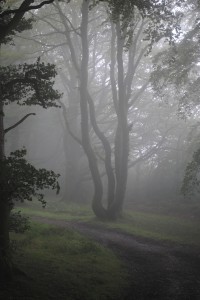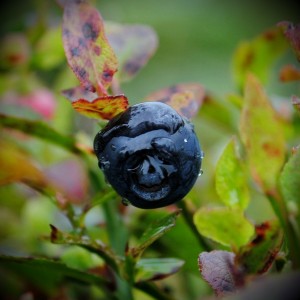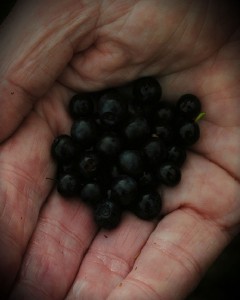Bilberries
 One of my abiding childhood memories is of my Polish grandparents taking me to the Quantock Hills in Somerset, near where they lived in Taunton, to pick bilberries and forage for mushrooms. Bilberries – which go by a variety of rather whimsical names around the country – are native blueberries, which grow on upland heath and mountainsides from Cornwall to the north of Scotland. Superficially similar to the cultivated blueberries available in shops, bilberries belong to a distinct section of the Vaccinium genus; they are smaller, with a more intense flavour and bright red flesh and juice that stains fingers purple.I visited my parents in the west country last week, and used the opportunity to revisit old haunts to see if the bilberries were out on the hillsides. We arrived at Lydeard Hill in thick fog which gradually cleared as the wind picked up. It didn’t look promising at first, but as we got higher up we found the distinctive green-and-red leaved bushes full of fruit.
One of my abiding childhood memories is of my Polish grandparents taking me to the Quantock Hills in Somerset, near where they lived in Taunton, to pick bilberries and forage for mushrooms. Bilberries – which go by a variety of rather whimsical names around the country – are native blueberries, which grow on upland heath and mountainsides from Cornwall to the north of Scotland. Superficially similar to the cultivated blueberries available in shops, bilberries belong to a distinct section of the Vaccinium genus; they are smaller, with a more intense flavour and bright red flesh and juice that stains fingers purple.I visited my parents in the west country last week, and used the opportunity to revisit old haunts to see if the bilberries were out on the hillsides. We arrived at Lydeard Hill in thick fog which gradually cleared as the wind picked up. It didn’t look promising at first, but as we got higher up we found the distinctive green-and-red leaved bushes full of fruit. Picking bilberries is an oddly addictive pursuit. At first the low, shrubby bushes appear empty. As my mother says, you have to ‘get your eye in’: close up the tiny berries reveal themselves and, once you find them, they’re everywhere. Having started, it’s hard to stop. We eventually filled two large containers with them without any great strain on our part.
Picking bilberries is an oddly addictive pursuit. At first the low, shrubby bushes appear empty. As my mother says, you have to ‘get your eye in’: close up the tiny berries reveal themselves and, once you find them, they’re everywhere. Having started, it’s hard to stop. We eventually filled two large containers with them without any great strain on our part.
It’s not been a great year for soft fruit, and the berries were a little sharp: there hasn’t been enough sunshine for them to sweeten. Nonetheless, they made a great crumble combined with apple, and they went well with Scotch pancakes the following morning. They make great jam as well. It looks like I’m going to have to wait until next year for that luxury though – our haul ran out pretty quickly.
